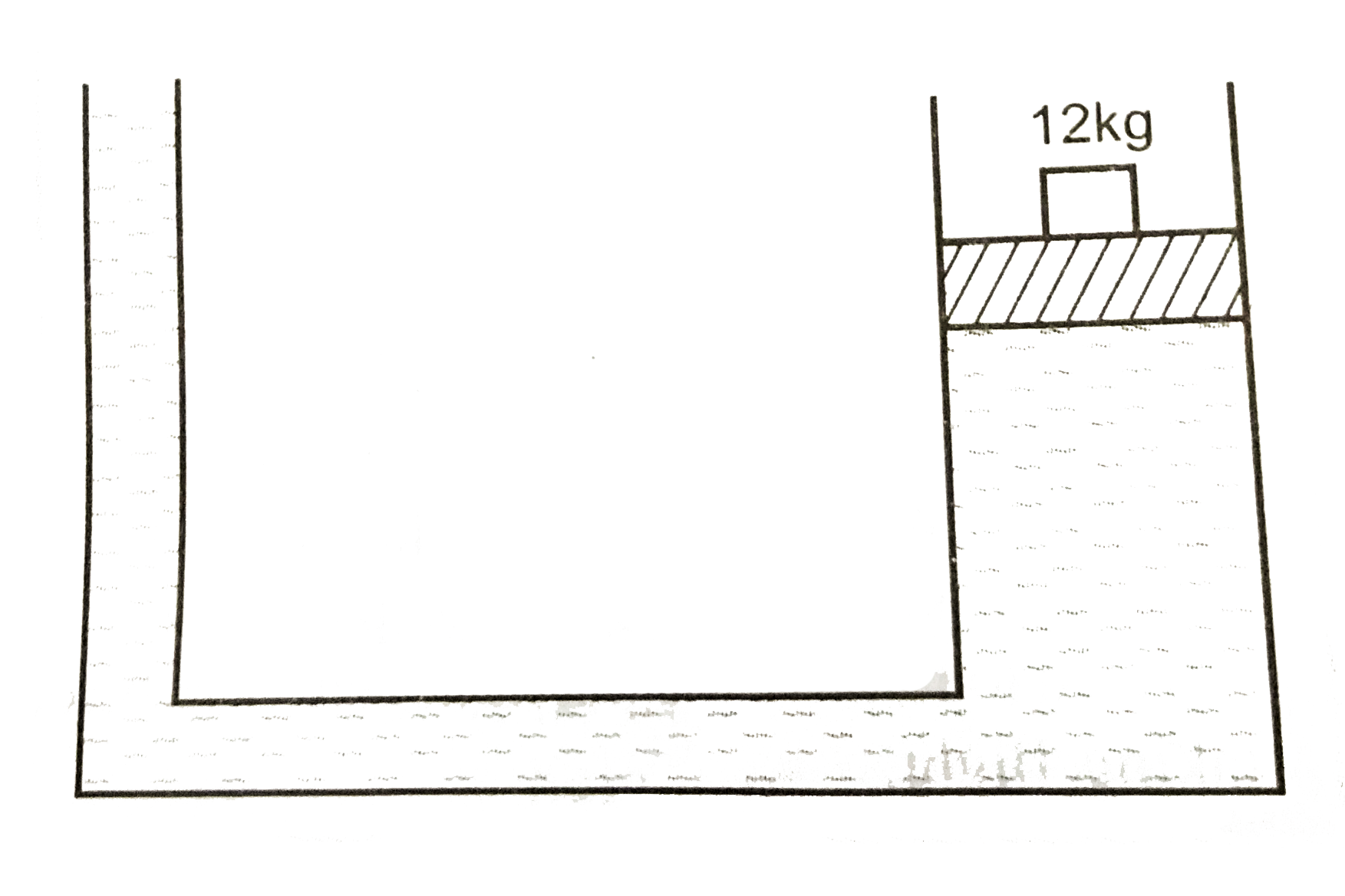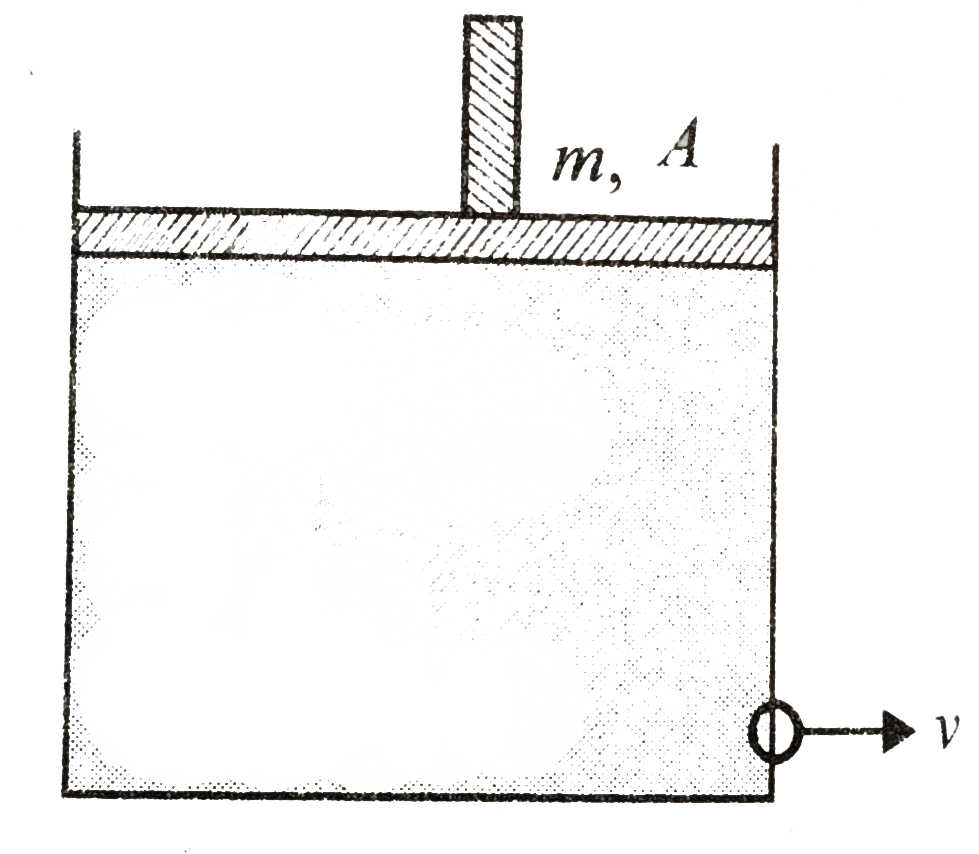A cylindrical tube with a frictionless piston ends in a small hole of area of cross–section , which is very small as compared to the area of cross-section of the tube. The tube is filled with a liquid of density . The tube is held horizontal and the piston is pushed at a constant speed so that liquid comes out of the hole at a constant rate . No liquid leaks around the piston. The material of the tube can bear a maximum pressure Pa. The maximum possible value of Q so that the tube does not break is __________ . [Atmospheric pressure Pa]
![A cylindrical tube with a frictionless piston ends in a small hole of area of cross–section 2xx10^(-6)m^(2), which is very small as compared to the area of cross-section of the tube. The tube is filled with a liquid of density 10^(4)kg//m^(3). The tube is held horizontal and the piston is pushed at a constant speed so that liquid comes out of the hole at a constant rate 'Q' m^(3)//s. No liquid leaks around the piston. The material of the tube can bear a maximum pressure 6xx10^(5) Pa. The maximum possible value of Q so that the tube does not break is xx10^(-5)m^(3)//s. [Atmospheric pressure = 10^(5) Pa]](https://d10lpgp6xz60nq.cloudfront.net/physics_images/VMC_JEE_MN_XI_FLT_05_E01_023_Q01.png)
The correct Answer is:2
Let atmospheric pressure be . Suppose the pressure inside the tube is (the maximum allowed) and the liquid comes out of the hole at speed v.
Since the hole is very small, the velocity of the liquid inside the tube will be negligible
Applying Bernoulli’s theorem,
Therefore, (area of cross-section of the hole)
Topper's Solved these Questions
- JEE MAIN - 5BOOK - VMC MODULES ENGLISHCHAPTER - JEE MAIN - 5EXERCISE - PART I : PHYSICS (SECTION - 2)
5 Videos
- INTRODUCTION TO VECTORS & FORCES BOOK - VMC MODULES ENGLISHCHAPTER - INTRODUCTION TO VECTORS & FORCES EXERCISE - JEE Advanced ( ARCHIVE LEVEL-2)
12 Videos
- JEE MAIN REVISION TEST - 30 | JEE -2020BOOK - VMC MODULES ENGLISHCHAPTER - JEE MAIN REVISION TEST - 30 | JEE -2020EXERCISE - PHYSICS
25 Videos
Similar Questions
In a hydraulic machine, a force of 2 N is applied on the piston of area of cross section 10cm2 . What force is obtained on its piston of area of cross section 100cm2 ?
View SolutionFigure shows a liquid being pushed out of a tube by pressing a piston. The area of cross section of the piston is 1.0 cm^2 and that of the tube at the outlet is 20mm2. If the piston is pushed at a speed of 2cms−1. What is the speed of the outgoing liquid?

View SolutionA cylindrical vessel of area of cross section A is filled with a liquid up to a height H. A very small hole of area of cross section a is made at the bottom of the vellel. Find the time taken by the vessel to become empty.
View SolutionWater rises to a height h in a capillary tube of cross-sectional area A. the height to which water will rise in a capillary tube of cross-sectional area 4A will be
View SolutionWater rises to a height h in a capillary tube of cross-sectional area A. the height to which water will rise in a capillary tube of cross-sectional area 4A will be
View SolutionThe area of cross section of the wider tube shown in figure is 900cm2. If the boy standing on the piston weights 45 kg, find the difference in the levels of water in the two tubes.

View SolutionThe area of cross-section of the wider tube shown in fig., is 800cm2 . If a mass of 12 kg is placed on the massless piston, what is the difference in the level of water in two tubes.

View Solution(a) What is meant by the principle of continuity ? Show that velocity of a liquid is inversely proportional to the area of cross-section of a pipe or tube.
View SolutionA cylindrical vessel contains a liquid of density ρ up to height h. The liquid is closed by a piston of mass m and area of cross section A. There is a small hole at the bottom of the vessel. The speed v with which the liquid comes out of the hole is

View SolutionA cylindrical vessel contains a liquid of density ρ up to height h. The liquid is closed by a piston of mass m and area of cross section A. There is a small hole at the bottom of the vessel. The speed v with which the liquid comes out of the hole is

View Solution
